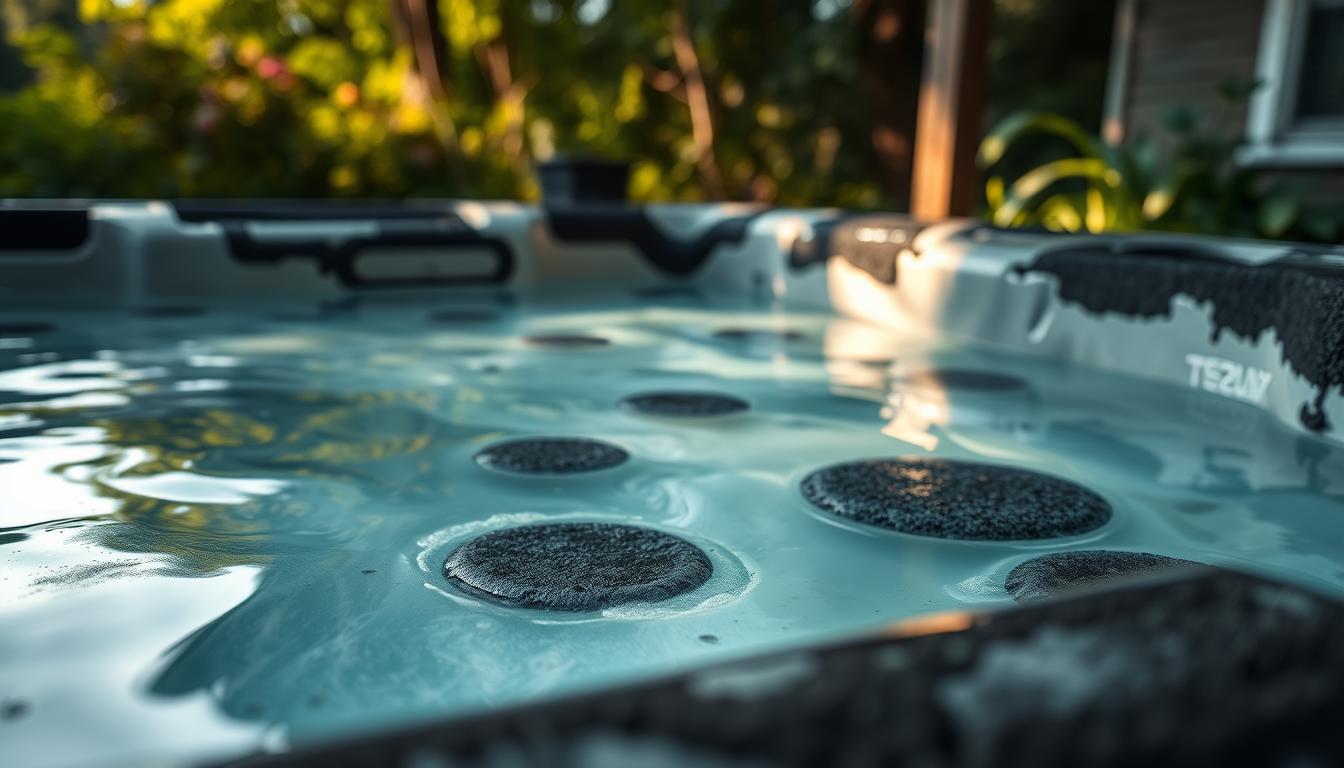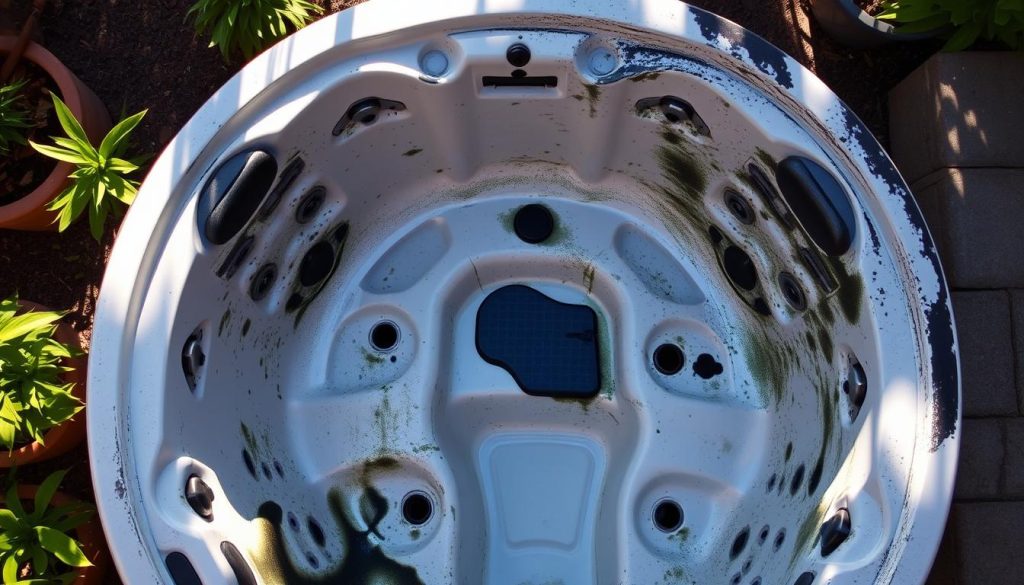
Black mold often grows on hot tub covers and headrests. It thrives in warm, moist environments with poor water sanitation. This toxic mold can be risky for people with weak immune systems.
Black mold in hot tubs can cause health problems. These include breathing issues, skin irritation, and neurological damage. Preventing mold growth is key for a safe hot tub experience.
Let’s explore black mold’s features and growth conditions. We’ll also look at the health risks of exposure in your hot tub.
What is Black Mold and How Does It Grow in Hot Tubs?
Black mold is a fungus that thrives in warm, humid places. It can harm hot tub users’ health and enjoyment. Understanding black mold helps prevent and address this issue.
Understanding the Characteristics of Black Mold
Black mold, or Stachybotrys chartarum, looks like dark, slimy patches. It smells musty and can grow on various hot tub surfaces. These include the cover’s underside, headrests, and around the waterline.

Ideal Conditions for Black Mold Growth in Hot Tubs
Black mold loves moisture, organic matter, and poor airflow. Hot tubs can create perfect conditions for mold growth. Several factors contribute to this problem.
- Imbalanced pH levels and insufficient sanitization chemicals
- Poor water circulation and filtration
- Lack of regular cleaning and maintenance
- Exposure to sunlight, which encourages algae growth
- Introduction of substances like soaps or lotions by bathers
To prevent mold, maintain proper water chemistry and clean filters regularly. Ensure good airflow and use mold-resistant materials. High-quality covers and shell surfaces can help fight mold.
| Hot Tub Maintenance Task | Frequency |
|---|---|
| Water testing and adjusting | Weekly |
| Filter cleaning | Monthly |
| Water drainage | A few times a year |
Follow a strict maintenance schedule to reduce mold risk. Use mold-resistant materials for better protection. These steps ensure a safe, fun experience for all hot tub users.
Health Risks Associated with Black Mold Exposure in Hot Tubs
Black mold in hot tubs can harm your health. It can cause short-term and long-term problems. These issues can affect many parts of your body.
Respiratory Issues Caused by Black Mold
Black mold can hurt your breathing. You might cough, wheeze, or have trouble catching your breath. It can make asthma worse.
About 70 cases of hot tub lung have been reported. Most happened with indoor hot tubs that had poor air flow.
Skin Irritation and Allergic Reactions
Touching black mold or dirty hot tub water can irritate your skin. It may cause redness, itching, or a rash called contact dermatitis.
People allergic to mold may sneeze or have a runny nose. They might get itchy eyes, skin rashes, or a sore throat.
In 2010, Ohio doctors found six patients allergic to PPMS, a hot tub cleaning chemical. This shows allergic reactions can happen.
| Health Risk | Symptoms |
|---|---|
| Respiratory Issues | Coughing, wheezing, shortness of breath, asthma exacerbation |
| Skin Irritation | Redness, itching, rash, contact dermatitis |
| Allergic Reactions | Sneezing, runny or stuffy nose, itchy and watery eyes, skin rashes, throat irritation |
Potential Long-Term Health Effects
Long-term mold exposure can cause serious health issues. It can lead to memory loss, trouble focusing, and mood swings. You might feel very tired or have a weak immune system.
Mold can harm your brain. It can cause swelling in the hippocampus and slow brain cell growth.
A study found mold exposure can hurt the nervous system. Brain scans showed problems in patients exposed to mold.
The diagnostic process for mold illness is often lengthy and challenging due to the wide range of physical, cognitive, and emotional symptoms associated with toxic mold exposure.
Treating mold sickness may involve removing mold from your home. You might need special treatment, diet changes, and brain health supplements.
It’s important to deal with mold in hot tubs quickly. This can help prevent long-term health problems.
Is Black Mold in Hot Tub Dangerous?
Black mold in hot tubs can be dangerous. The risk depends on several factors. A small amount may not harm healthy people right away.
But long exposure or a big outbreak can cause health problems. It’s important to know how bad the mold is. Quick action is key to fixing the issue.
Assessing the Severity of Black Mold Infestation
To gauge the danger, check how much mold is in the hot tub. Look inside the tub, jets, and water line for dark spots or slime.
A musty smell can also signal mold. If you see a lot of mold, it might have spread to hidden areas.
Consider getting a pro to test for mold in your hot tub. This will tell you how serious the problem is.
Factors that Influence the Level of Danger
Several things affect how risky black mold in a hot tub can be:
- Individual health status: People with breathing issues, weak immune systems, or mold allergies are at higher risk.
- Duration of exposure: The longer you’re around mold, the more likely you’ll have health problems.
- Environmental conditions: Poor airflow, high humidity, and rare cleaning help mold grow faster.
- Water chemistry: Bad water care can make mold grow and spread more.
To lower health risks, focus on safe hot tub care. Clean often and keep water chemistry right. Make sure the area has good airflow.
Act fast if you see any mold growing. Taking care of your hot tub helps prevent mold and keeps you safe.
The key to preventing black mold growth and its potential health risks lies in consistent and thorough hot tub maintenance. By staying vigilant and addressing any issues promptly, you can ensure a safe and enjoyable hot tub experience for yourself and your loved ones.
| Factor | Impact on Mold Growth | Preventive Measures |
|---|---|---|
| Poor Ventilation | Increases humidity and promotes mold growth | Ensure proper ventilation and air circulation |
| Infrequent Cleaning | Allows organic matter to accumulate, providing a food source for mold | Establish a regular cleaning schedule and thoroughly clean all surfaces |
| Improper Water Chemistry | Creates an environment conducive to mold growth | Maintain proper sanitizer levels and balanced pH |
| Prolonged Exposure | Increases the risk of experiencing adverse health effects | Limit exposure time and address mold issues promptly |
Conclusion
Black mold in hot tubs can be dangerous. It’s especially risky for people with breathing problems, allergies, or weak immune systems. Mold in indoor spaces can cause asthma, wheezing, and coughing. Hot tub owners must prevent black mold to protect users’ health.
Understanding what helps black mold grow is key. It thrives in warm, damp places like hot tubs. Proper maintenance is crucial to stop mold growth. This includes regular cleaning and balancing water chemistry.
Look out for signs of black mold. These include musty smells, stains, or water damage. If you spot mold, act fast to stop it from spreading. For big mold problems, call in the experts.
Keep your hot tub clean and learn about black mold dangers. This will help ensure a safe and fun hot tub experience for everyone.







